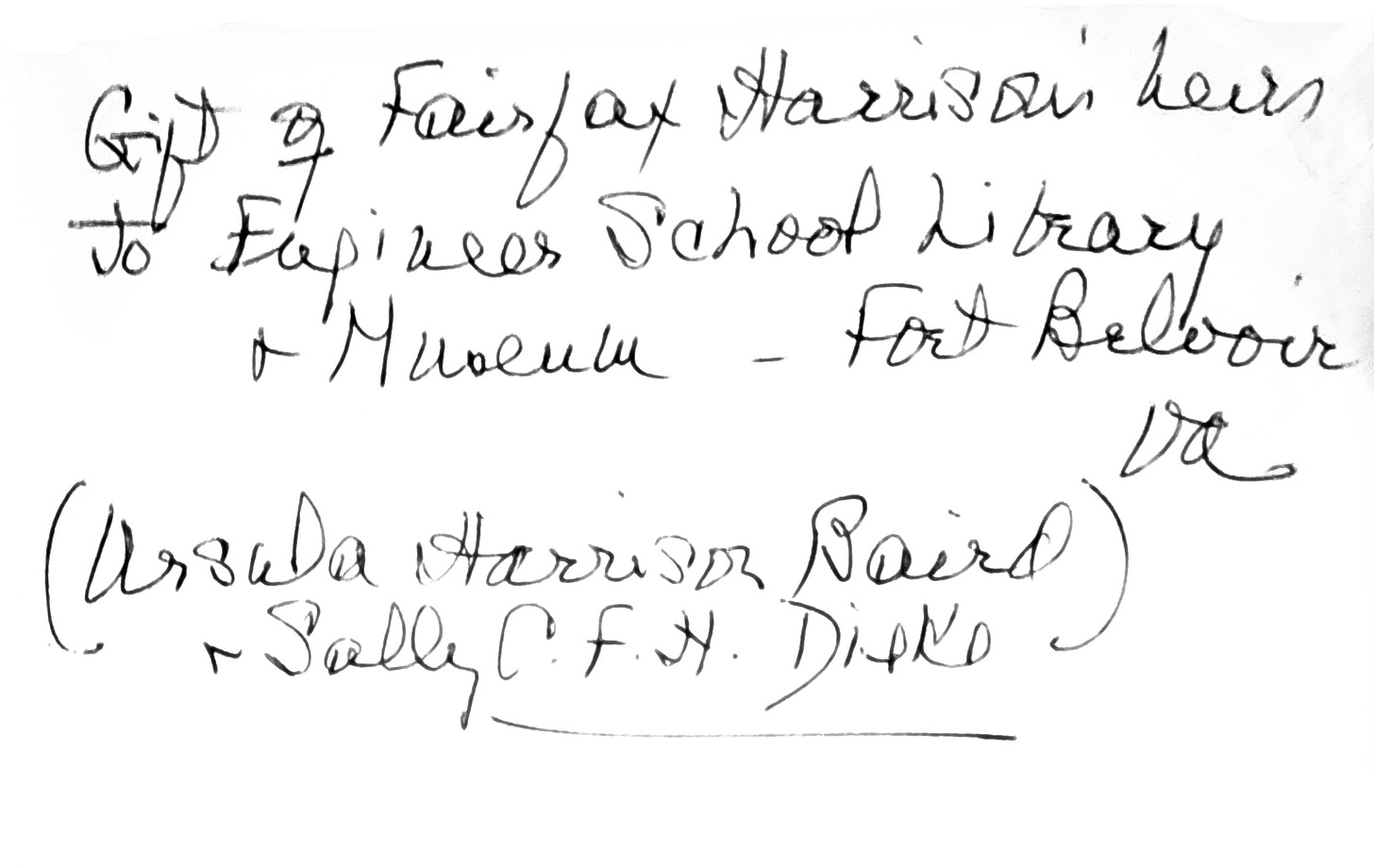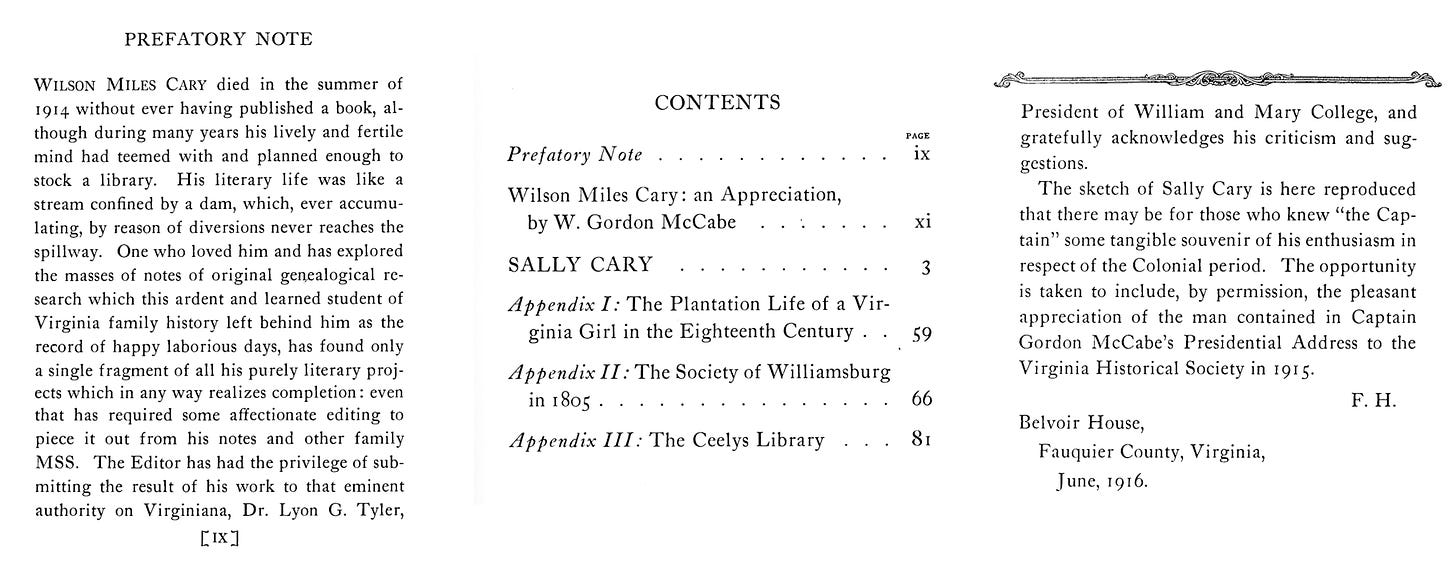From the Shelves: Sally Cary, Fairfax Harrison, and F.F.V. Stud Blood.
I grab my trusty pocket knife, make short work of the tape, and open the box. Inside is a book, but not one I ordered. It’s a gift, courtesy of Percy Gryce, a bookman’s bookman.
The Book
Sally Cary: A Long Hidden Romance of Washington's Life by Wilson Miles Cary (1838-1914). Its format or size is common. Octavo they call it, 8vo for short. Cloth-bound in orange, plain as a church pew, marked only by a simple paper label on its spine. I found a single copy for sale; the majority reside in libraries.
On the front free endpaper (ffep), there’s an inscription, which I can’t fully decipher: “Gift of Fairfax Harrison[’s heirs?] to Engineer School Library & Museum - Fort Belvoir, VA (Ursula Harrison Baird & Sally C.F.H. [Cary Fairfax Harrison] Dieke)”
I turn to the title page. It was printed privately in 1916 by The De Vinne Press. There’s mention of “Notes by Another Hand.” Soon enough, I find that hand belongs to Fairfax Harrison. The “Prefatory Note” is signed F.H. Belvoir House, Fauquier County, Virginia, June, 1916.
Initially, the book felt out of my element, wasn’t familiar with any of the names, except the one, Washington, of course. Yet, I knew I'd write about it, for writing is the path to knowing, and knowing fills the shelves with more books.
I checked the old quarterlies for reviews and found them. One reviewer remarked on the good fortune of acquiring such a handsome volume. Another mentioned the author, Wilson Miles Cary of Baltimore, a man with many ambitions but only one book to show for it, and even that, unfinished.
Ladies First
I’d seen the name Sally Cary [Fairfax] in print before. But my memory is as reliable as a politician's promise. I open my Google Drive (the digital Villa of the Papyri of the South) and call her name.
I find her in:
- several volumes of Douglas Southall Freeman’s George Washington.1
- Jay B. Hubbell’s essay “Thackeray and Virginia”.
- the footnotes of George Washington, the Virginia Period, 1732-1775.
- the niche volume The Library At Mount Vernon.
- the Virginia Magazine of History and Biography essay “George Washington in American Fiction”.
- Samuel Eliot Morison’s address “The Young Man Washington”
- the great-titled book George Washington's South.
- The Diaries of George Washington.
- John Richard Alden’s George Washington: A Biography.
- Bernard Mayo’s lecture “George Washington,” delivered at Mercer University and included in his Myths and Men: Patrick Henry, George Washington, Thomas Jefferson.
All covered similar ground—the same dirt, no matter where you dig. Young Washington, not yet etched into numismatic immortality, had ambitions vast as the frontier. He was a man. His heart stirred. As men's hearts do. Yes, “there were the slanders about his love affair with Sally Fairfax,” the wife of his friend George William Fairfax. But his character was unyielding. The understood lines. They weren’t crossed. Born A gentleman born, a gentleman he died.2 But I’m not here to sift dirt. You can read all about it on the information highway. The Lady of Belvoir isn’t my main focus today, and you can't chase every rabbit that crosses your path.
Fairfax Harrison
A man wonders. What if money came down like manna, or better yet, what if you'd slid out of the womb with a silver toothpick dangling from your mouth? There’d be signs. I’d basically become Mr. Fairfax Harrison.
Lawyer, Railroad Tycoon, historian, and Virginiana collector, Reginald Fairfax Harrison (1869-1938), lived in the shade of history. The son of Burton Harrison, secretary to Confederate President Jefferson Davis, and Constance Cary Harrison, a writer who, together with two cousins, were dubbed the "Cary Invincibles" and stitched the first few Confederate Battle Flags.3

Harrison started his railroad work in New York, wrestling with legal matters for the Southern Railway. By 1896, he moved to Washington as its solicitor and penned a legal history in 1901. He rose to assistant president in 1903 and vice-president by 1906, steering the company through the panic of 1907. After a stint leading the Monon Railway, he took over Southern in 1913, facing war and economic collapse head-on. In 1917, as chairman of the Railroads' War Board, he took the reins, driving a hard effort to unite the railroads and keep the government at bay. Even in the depths of the 1930s, he cut his own pay and fought for the company’s survival. By 1937, when he retired, Southern Railway had begun to rise again.
“Fairfax Harrison, son of Burton N. Harrison, private secretary to President Davis, and himself a brilliant inheritor of great traditions, gave encouragement at every stage of the work and critically read the MS. of the final operations of the war.”
- Douglas Southall Freeman4
He was friends with Lyon Gardiner Tyler and corresponded with Classicists, Lord Fairfax, William Cabell Bruce and historians such as William E. Dodd, Ulrich B. Phillips, Charles McLean Andrews, Percy Lee Rainwater, J. Franklin Jameson, and Douglas Southall Freeman.5
Harrison came to the lettered world and planted his flag. His natural gift for the written word mingled with his command of languages, both the moth-eaten tongues of antiquity and the new. He wrote on classical education, the renewal of the postbellum South, and horses—iron and equine. Things that called to such a man. But the old blood sang louder still. It sang of Virginia and her First Families.
Harrison's commitment to the history of the Old Dominion and the South was not so much a calling as it was the very marrow of his being. He was devoted, almost reverently. A gentry monk, genuflecting at the altar of the Mother of States. When precious manuscripts or maps eluded his grasp, he took decisive action, ensuring that copies found their way into the hands of other scholars and institutions. He “originated the Virginia Historical Index,”6 born of a conviction that to chart the future, one must first map the past. He selected 120 volumes, each a repository of truths he deemed essential. His hope was that other states would follow his lead and do the same.
Old Harrison stood firm, a stubborn guardian against the tide of forgetting. A keeper of the flame. Memory's custodian. A steadfast link to what had come before. It’s easy enough to understand why the Cary book found its way into print.
As with Mrs. Fairfax, I had encountered Harrison's name before, a fact that only became apparent upon discovering its repeated presence in the footnotes and bibliographies of several major works I’ve read. Yet, most of his works remain obscure, hidden away. He'd not sell them. Nor print them in number. But the web. It found them. Dragged them into light. I know where they lie.7
Landmarks of Old Prince William, a Study of Origins in Northern Virginia, Volume I.
Landmarks of Old Prince William, a Study of Origins in Northern Virginia, Volume II.
Virginia Land Grants: A Study Of Conveyancing In Relation To Colonial Politics.
Early American Turf Stock, 1730-1830: Being a critical study of the extant evidence for the English, Spanish and Oriental Horses and Mares to which are traced the oldest American Turf Pedigrees, Volume One, Mares.8
The Proprietors of the Northern Neck, Chapters of Culpepper Genealogy.
A History of the Legal Development of the Railroad System of Southern Railway Company.
The Southern Railway As A Factor In The Progress Of Georgia.
It's unfortunate that no biography of Fairfax Harrison exists.9 Even a dissertation is lacking, though one was written about his mother.10 With his Collected Papers at several institutions in Virginia and Maryland, there’s a great research opportunity waiting for someone. I’d especially like to see the following published: His “notes concerning thoroughbred horses compiled for a planned publication, ‘Portraits of English Turf Horses before [George] Stubbs’ (copy of manuscript included).” And a catalog of his collection of books on the history of sport.11
The De Vinne Press
The De Vinne Press represents another complex facet of this history. Functioning as the Grolier Club's de facto private press, it holds considerable significance in the field.12
Theodore Low De Vinne's ascent in American printing was not mere happenstance. Through unparalleled skill and penetrating insight, he reshaped the landscape of his craft. His innovations and leadership elevated him to the status of “Dean of American Printers.” As a founder of the prestigious Grolier Club, De Vinne left an indelible mark, designing and printing many of its significant publications..13
Raises glass to Percy:
“. . . as from one laborer In the vineyard to another expresses a common ambition for the future of the South. I salute you with best wishes.”
Letter to Dr. Douglas Southall Freeman, Richmond, Virginia. December 27, 1916.14
See Mayo “George Washington”.
I used several sources for the bio. "Fairfax Harrison." Dictionary of American Biography. New York, NY: Charles Scribner's Sons, 1944. “Fairfax Harrison, An Appreciation”. Virginia Magazine of History and Biography 46.2, 1938. “Fairfax Harrison”. William and Mary Quarterly 18.2, 1936.
Other good sources on Harrison:
- “Who was Reginald Fairfax Harrison?”
- Online Books Page
- Archive results, He’s mentioned a bunch.
R. E. Lee, A Biography IV, p. 531.
See his A Selection of the Letters of Fairfax Harrison (Several great letters. Click the link, and search the document for “South” or “history”) and Ulrich Bonnell Phillips: Historian of the Old South. Dillon, Merton L. Published by Louisiana State University Press, Baton Rouge, 1985.
“Fairfax Harrison”. William and Mary Quarterly 18.2, 1936.
I think I’m the first to add several of these to the internet archive.
There are three volumes in this set, and I haven’t found 2 & 3. They seem to be rare and $$$.
Burke Davis’ The Southern Railway: Road Of The Innovators, probably comes closest.
Constance Cary Harrison: American Woman of Letters, 1843-1920. Maxwell, Sherrolyn. University of North Carolina at Chapel Hill, Ph.D., 1977.
Fairfax Harrison Papers at the Virginia Museum of History & Culture.
The majority of Harrison’s work was printed by the Old Dominion Press in Virginia.
“The De Vinne Centennial”
Types of the De Vinne Press (1907). It’s not a cheap one to add to your shelves.
The De Vinne Press Building: “A Tour-de-force of Bricklaying” at 393-399 Lafayette Street








